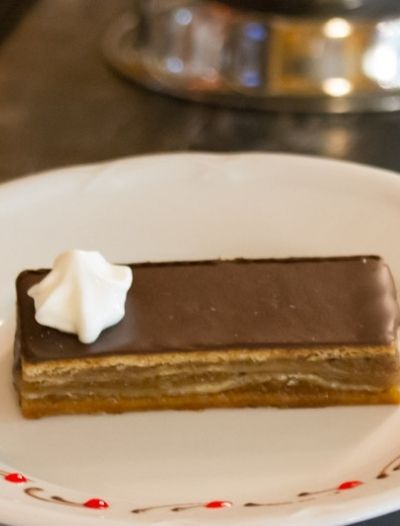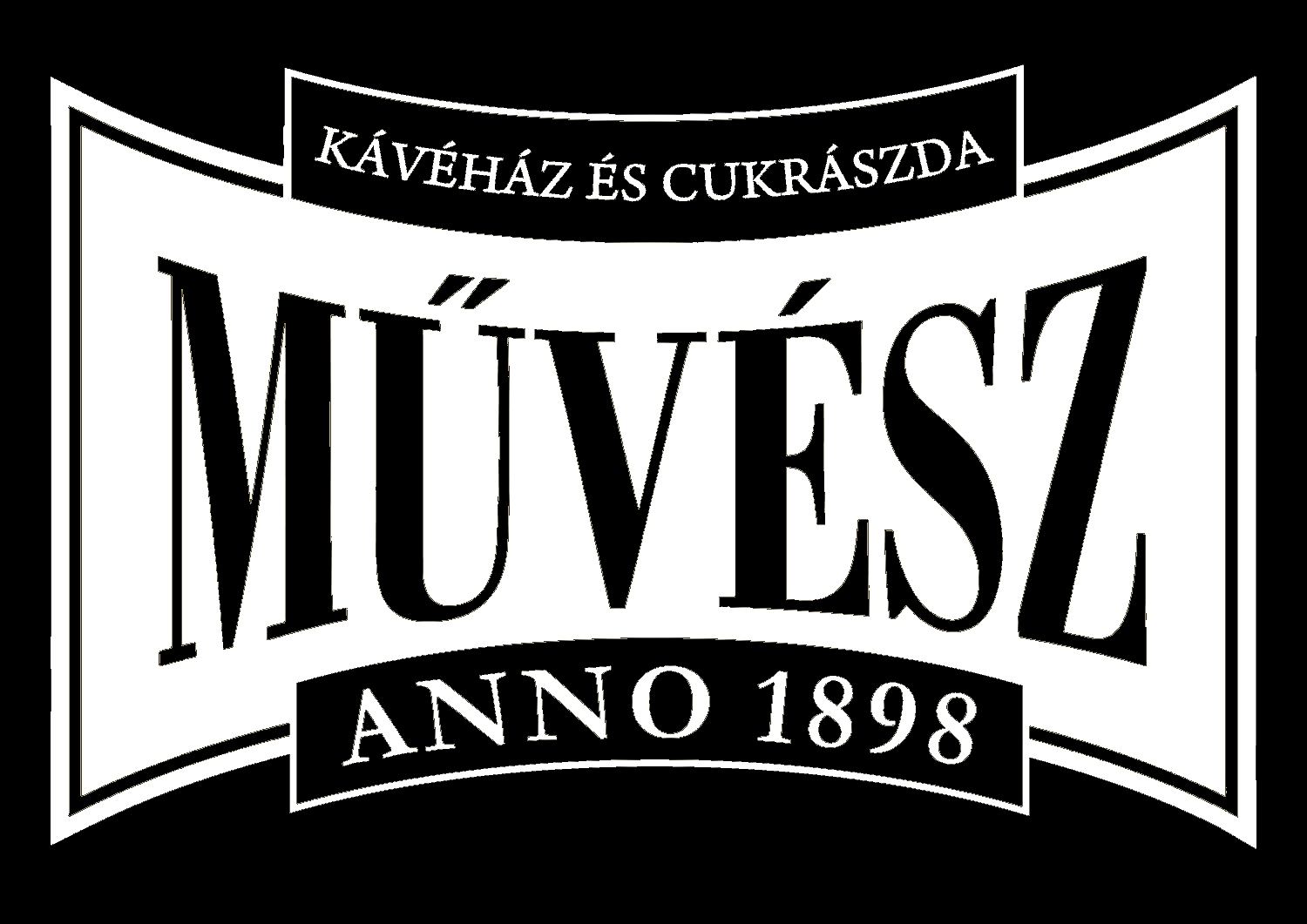MŰVÉSZ CAFÉ & CONFECTIONERY
Famous
Cakes

ANDRÁSSY SLICE
Gyula Andrássy (1823-1895), count, politician, member of the Hungarian Academy of Sciences. After completing his legal studies, he traveled to France, from where he actively participated in domestic public life. In the beginning, he was an ardent supporter of Széchenyi, but in 1847 he was elected a member of the Zemplén county parliament, after which he joined the followers of Kossuth. In 1849, he became the head master of his county and then the commander of the national guards. He participated with a weapon in the battles of Pákozd and Schwechat, during the spring campaign he was Görgey’s assistant officer. In the summer of 1849, he became the ambassador of the Hungarian government in Constantinople. After the lay-down of arms, he acted with the Turkish government on behalf of the refugees. In 1851, he was sentenced to death in absentia, so exile awaited him. He settled in Paris and, breaking with his previous views, set out for an agreement with Austria. In 1858, he received amnesty and, upon returning home, joined Ferenc Deák’s circle. After the settlement, he became the first Prime Minister and Minister of National Defense at the same time, and played a major role in creating the dualistic state order. During the Prussian-French war, he supported the neutrality of the Monarchy. In 1871, he won the post of Minister of Foreign Affairs. Due to the difficulties associated with the occupation, in 1879 there were fierce attacks, so he resigned. After that, he retired from politics.

DOBOS CAKE
Dobo cake is a so-called “hungaricum”, created by József C. Dobos (1847-1924). Although his name is primarily associated with his cake, he was a cook and confectioner, but never owned a pastry shop. Descendant of a real chef dynasty, his great-grandfather was a master chef in Ferenc Rákóczi’s castle in Szerencs, and he himself started learning this craft alongside his father. In 1878, in a somewhat unusual way, he opened a delicatessen in Kecskemét Street, where he sold home-made food, preserves, and sweets, and undertook to cater for home celebrations, prepare food lines, and organize events. Due to his excellent knowledge, many noble families used his services, and it became fashionable to order or eat from him. He was a versatile person, an excellent professional writer of his time, an educated and witty conversationalist. In about 15 volumes, he published his professional knowledge, the workshop secrets he had learned over the years, the gastronomic experiences of his travels abroad, and anecdotes related to food. His most famous book published in Hungarian is the Hungarian-French Cookbook published in 1881. When he made the confection named after him, his goal was to make a cake that could be eaten and enjoyed for a long time even with the slightly backward cooling techniques of the time. He created the drum cake for the 1885 national exhibition – around this time he also had a restaurant in Városliget. Queen Elizabeth and Franz Joseph were among the first to taste the soon-to-be-famous sweet here, but the Prince of Wales and Bavaria, the Bulgarian prince, Prime Minister Count Kálmán Tisza were also guests. The cake made the connoisseurs and confectioners of Budapest go crazy. For a long time, his competitors failed to imitate his product. Dobos finally handed over the original recipe to the industrial board in 1906.

ESTERHÁZY CAKE
The members of the long-standing and extensive Esterházy family were one of the most influential and richest noblemen in Hungary. They considered themselves descendants of one of the oldest Hungarian families. Their origins can be traced back to the Solomon dynasty of the Árpád era. The Esterházys loved the arts. Prince József Miklós, who lived in the second half of the 18th century, was also extremely skilled in the arts and was happy to support talented artists. He built the Esterházy Castle (located in today’s Fertőd) on one of the family estates, which is said to have rivaled the castle complex of Versailles in France in its beauty. Joseph Haydn was also a court musician in the courts of “Shiny” Miklós at Kismarton and Eszterháza. In addition to the arts, the Esterházys also devoted themselves to the art of cooking. Nothing proves this better than the food specialties that bear the name Esterházy. For example, the particularly delicious and sweet cake, the Esterházy cake, or the “classic” grilled or beef steak, named after Prince Pál Antal Esterházy, foreign politician and diplomat. The Eszterházy cake was named after the count, but it was first made not in Hungary, but in Austria. The nutty, creamy miracle is a must in every pastry shop, so we are no exception.

GERBEAUD SLICE
When a caramel vase decorated with a sugar flower bouquet was presented at the national exhibition in 1885, the visitors were amazed; at home at that time, they couldn’t even imagine that such an artistic work could be made from sugar. The creator, Emil Gerbeaud (1854-1919), was a confectioner born in Geneva, who – after working in France, England, and Germany – was came to Hungary in 1884 at the invitation of the then famous confectioner Henrik Kugler. In a short time, he gained a very high professional reputation and soon became a partner, then took over Kugler’s Gizella-tér (today Vörösmarty tér) store, which he furnished with industrial art furniture, marble tables, artistic paintings, and valuable carpets. His patisserie, evoking a Parisian atmosphere and French spirit, became one of the city’s best-known stores, frequented by royal princes, aristocrats, and industrial tycoons. He invented cognac cherries, the so-called “cat’s tongue” and chocolate dragée. He also exported his bonbons packed in wooden boxes to countries outside of Europe. Even in everyday work, he really composed his preparations, he strove for the perfect unity of material and form in confectionary. In terms of the quality of the products and the level of sales, he was not willing to make any concessions. He was a true artist of his profession.

SACHER CAKE
The original chocolate cake, which has deservedly become world famous, is made in the Sacher pastry shop in Vienna. The cake is decorated with Sacher’s inscription and seal, thereby emphasizing the uniqueness of the recipe. This candy was invented in 1832, at the age of sixteen, by confectioner Franz Sacher. In his thirties, the already well-known confectioner (he also worked for the Esterházy family) opened a delicatessen in Vienna in one of the streets near Saint Stephen’s Cathedral. Later, Franz Sacher’s son built the hotel bearing their family name at this location, which today has the following address: Philharmoniker Strasse 4. Here you can still taste or buy the real, original Sacher cake. In fact, the pastry shop also delivers Sacher cakes to all parts of the world on orders (carefully packed in wooden boxes).

RODOLFÓ FRUIT CAKE
“Watch my hands, because I’m cheating!” – Rodolfo, whose civil name was Rezső Gács (1911-1987), told the astonished audience during his lectures, but because of his amazing professional knowledge, he was able to keep the secrets of his magician’s tricks all the time. He was born in Budapest as a child of a poor printer’s family. He was inspired to do magic by a Chinese pearl seller, who taught him a magic trick with Danube pebbles. He was embraced and taught by Odry Zuárd in the second half of the 1920s. His first solo performance was also managed by his master in the spring of 1929, and from then on, the young magician was invited to perform by numerous associations, clubs, professional and friendly circles in Pest and Buda. It was then that he received the stage name Rodolfo Grosso from his master.
In 1930, he applied for admission to the Association of Hungarian Amateur Magicians, but despite his success, he was not accepted. Three days later, after his highly successful exam performance, he became a member of the Hungarian Acrobat Association. The nimbus of the young, black english mustached magician was growing. He got married in 1935. It was around this time that the artists’ company was organized, of which he was a member, along with the Latabár brothers, Kamill Feleki and Alfonzó, and entertained the Moulin Rouge audience with great success. Rodolfo left the troupe at the beginning of 1939 and started an independent revue group. On the occasion of his fiftieth birthday, he received the honorary title of Merited Artist (1960), and in 1971 (when he retired) the honorary title of Outstanding Artist. From 1962, he was employed by the Hungarian Circus and Varieté Company (MACIVA), and gained considerable merit in the restoration of the new Budapest Grand Circus (1971). He was awarded the SZOT award in 1980. His last public performance was on January 13, 1986 at the Microscope Stage. (Rodolfo: Beware! I cheat!) He died on January 25, 1987 in Budapest.
You can find us at
1061 Budapest, Andrássy str. 29.
Contact
+36 (70) 333-2116
+36 1 343 3544
info@muveszkavehaz.com
Opening Hours
Monday - Saturday: 9:00 - 20:00
Sunday & Holidays:
9:00 - 20:00

We look forward to hearing your questions and comments via our phone contacts or by message!
![]()
![]()
![]()
![]()



